INTRODUCTION
This document provides an overview of the California Department of Corrections and Rehabilitation’s (CDCR) nonviolent parole review process implemented under Proposition 57 (approved by the voters in November 2016). Under Proposition 57, persons convicted of nonviolent offenses are eligible for parole consideration by the Board of Parole Hearings (Board) once they have served the full term of their “primary offense,” which is defined as the longest term of imprisonment imposed by the court, excluding the imposition of an enhancement, consecutive sentence, or alternative sentence.1
DEFINITION OF NONVIOLENT OFFENSE
Regulations implementing Proposition 57’s parole consideration process went into effect on July 1, 2017.2 Under the regulations, a nonviolent offense is any crime not listed as a “violent felony” under Penal Code section 667.5, subdivision (c).3
1 Cal. Const., art. I, § 32, subd. (a), par. (1).
2 Cal. Code Regs., tit. 15, §§ 2449.1-2449.7, 3490-3491.
3 Penal Code, § 667.5, subd.(c) provides:
For the purpose of this section, “violent felony” shall mean any of the following:
(1) Murder or voluntary manslaughter.
(2) Mayhem.
(3) Rape as defined in paragraph (2) or (6) of subdivision (a) of Section 261 or paragraph (1) or (4) of subdivision (a) of Section 262.
(4) Sodomy as defined in subdivision (c) or (d) of Section 286.
(5) Oral copulation as defined in subdivision (c) or (d) of Section 287 or of former Section 288a.
(6) Lewd or lascivious act as defined in subdivision (a) or (b) of Section 288.
(7) Any felony punishable by death or imprisonment in the state prison for life.
(8) Any felony in which the defendant inflicts great bodily injury on any person other than an accomplice which has been charged and proved as provided for in Section 12022.7, 12022.8, or 12022.9 on or after July 1, 1977, or as specified prior to July 1, 1977, in Sections 213, 264, and 461, or any felony in which the defendant uses a firearm which use has been charged and proved as provided in subdivision (a) of Section 12022.3, or Section 12022.5 or 12022.55.
(9) Any robbery.
(10) Arson, in violation of subdivision (a) or (b) of Section 451.
(11) Sexual penetration as defined in subdivision (a) or (j) of Section 289.
(12) Attempted murder.
(13) A violation of Section 18745, 18750, or 18755.
(14) Kidnapping.
It is important to note that although most nonviolent crimes involve criminal conduct in which there is no physical injury, many crimes involving physical injury or threat of physical injury are considered “nonviolent” because they are not a “violent felony” under Penal Code section 667.5, subdivision (c). Examples of crimes excluded from the definition of a violent felony under Penal Code section 667.5, subdivision (c) that involve physical injury or threat of physical injury include the following:
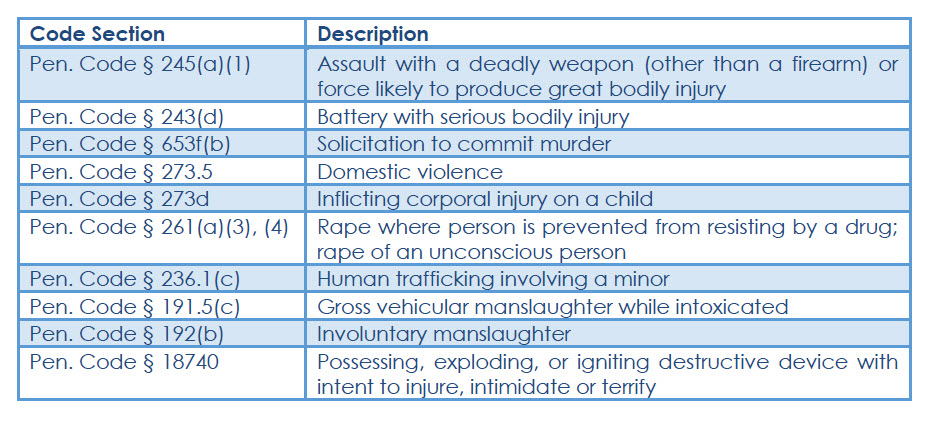
HISTORY OF NONVIOLENT PAROLE REVIEW
Overview- The nonviolent parole review process actually began prior to Proposition 57 and the number of people eligible for parole review has expanded significantly as a result of litigation since Proposition 57 was first enacted.
(15) Assault with the intent to commit a specified felony, in violation of Section 220.
(16) Continuous sexual abuse of a child, in violation of Section 288.5.
(17) Carjacking, as defined in subdivision (a) of Section 215.
(18) Rape, spousal rape, or sexual penetration, in concert, in violation of Section 264.1.
(19) Extortion, as defined in Section 518, which would constitute a felony violation of Section 186.22.
(20) Threats to victims or witnesses, as defined in Section 136.1, which would constitute a felony violation of Section 186.22.
(21) Any burglary of the first degree, as defined in subdivision (a) of Section 460, wherein it is charged and proved that another person, other than an accomplice, was present in the residence during the commission of the burglary.
(22) Any violation of Section 12022.53.
(23) A violation of subdivision (b) or (c) of Section 11418. The Legislature finds and declares that these specified crimes merit special consideration when imposing a sentence to display society’s condemnation for these extraordinary crimes of violence against the person.
The Proposition 57 nonviolent parole review process was patterned after a similar process referred to as the nonviolent, second-striker parole review process, implemented in January 2015 under a court order by the Three Judge Panel in the Plata/Coleman class action litigation.4 The parole review process was one of several initiatives in the court order intended to reduce the prison population so that a constitutional level of medical and mental health care could be provided. Key provisions of the court-ordered nonviolent, second-striker parole review process included the following:
- Eligibility – persons sentenced to a second strike for a felony offense that was not a violent felony under Penal Code section 667.5, subdivision (c) were eligible for parole consideration
- Time Served – persons were eligible once they served 50 percent of their total term
- Exclusions – indeterminately-sentenced persons and people required to register as a sex offender were excluded
- Additional Requirement – eligible persons had to pass public safety screening criteria to be referred to the Board for parole consideration; the public safety screening criteria excluded persons from parole consideration based on negative in-prison behavior, such as two or more serious rules violations within the preceding year or a Security Housing Unit term within the preceding five years.5,6
Proposition 57 expanded the criteria for nonviolent parole consideration. As originally enacted in 2017, all determinately- sentenced persons convicted of nonviolent offenses were eligible for parole consideration under
4 Coleman v. Brown, (E.D.Cal. Feb. 10, 2014, No. 2:90-cv-00520-LKK DAD (PC), 2014 WL 2889598, 2014 U.S.Dist. Lexis 17913); Plata v. Brown (N.D. Cal., No. 3:01-cv-01351-TEH).
5 Serious rule violations include offenses, which could be punished as a misdemeanor or felony, or that involve force, a breach or hazard to security, a serious disruption to facility operations, or introduction of a controlled substance or dangerous contraband into the facility. (Cal. Code Regs., tit. 15, § 3315.) The Security Housing Unit houses people whose conduct endangers the safety of others, including those found guilty of serious misconduct. (Cal. Code Regs., tit. 15, § 3341.3.)
6 Former Cal. Code Regs., tit. 15, § 3492 (repealed) stated in relevant part:
(c) An inmate is eligible for referral to the Board of Parole Hearings if, on the date of the screening, all of the following are true:
(1) The inmate is not currently serving a Security Housing Unit term;
(2) The Institutional Classification Committee has not assessed the inmate a Security Housing Unit term within the past five years, unless the department assessed the Security Housing Unit term solely for the inmate’s safety;
(3) The inmate has served a Security Housing Unit term in the past five years that was not assessed solely for the inmate’s safety;
(4) The inmate had been found guilty of a serious rule violation for a Division A-1 or Division A-2 offense within the past five years;
(5) The inmate has not been assigned to Work Group C in the past year;
(6) The inmate has not been found guilty of two or more serious Rules Violation Reports in the past year;
(7) The inmate has not been found guilty of a drug-related offense or refused to provide a urine sample in the past year;
(8) The inmate has not been found guilty of any Rules Violation Reports in which a Security Threat Group nexus was found in the past year.
Proposition 57, not just persons whose sentences had been doubled as a second strike. As a result, persons sentenced to multiple consecutive terms without a second strike were eligible for the process under Proposition 57. In addition, many were eligible for parole review earlier in their sentence – once they served the full term of their primary offense, rather than 50 percent of their total term.
As illustrated below, under Proposition 57 the amount of time some people have to serve before they are eligible for parole consideration is the same as it was under the court-ordered process; however, for others it is much less than 50 percent of their total term, depending on their convictions and how they were sentenced.
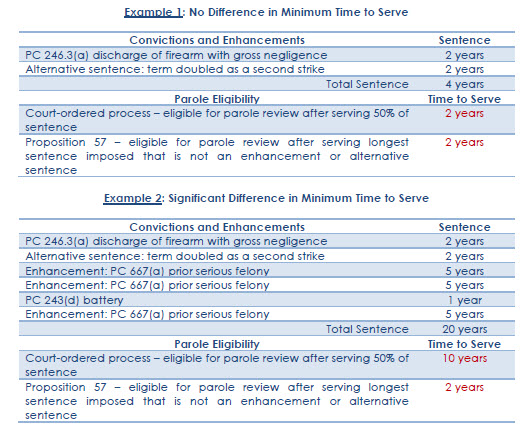
As a result, when Proposition 57 was first implemented, many people eligible for parole review had more recent criminality (i.e., they were eligible for parole consideration earlier in their term, prior to serving 50 percent of their sentence) and many had more criminality (i.e., more convictions) than those who were eligible under the court-ordered process.
In addition, expanded credit earning under Proposition 57 went into effect in August of 2017. This means that persons who behave well and engage in rehabilitative programming in prison and who are serving the shortest sentences for nonviolent offenses are now often released “on the natural” based on the sentence imposed by the court and their credit earning rather than being referred to the Board for parole consideration, as they were under the court-ordered process. Only persons serving longer sentences for nonviolent offenses or persons whose release dates have been extended as a result of rules violations are incarcerated long enough to be considered for parole by the Board under Proposition 57.
Lastly, as initially enacted, the Proposition 57 nonviolent parole review process excluded persons required to register as a sex offender and eligible persons had to pass the same safety screening criteria used for the court-ordered process to be referred to the Board for parole consideration.
Expansion of Proposition 57 by Case Law
As mentioned above, the nonviolent parole review process under Proposition 57 has been the subject of significant litigation, which has further expanded the number of persons eligible for parole consideration. For example, in July 2019, CDCR removed the public safety screening criteria in response to the First Appellate District Court of Appeal’s decision in In re McGhee and indeterminately-sentenced persons convicted of nonviolent offenses became eligible for parole consideration as a result of the Second District Court of Appeal’s decision in In re Edwards.7 Lastly, persons convicted of nonviolent offenses who are required to register as a sex offender are now eligible for parole consideration under the California Supreme Court’s decision in In re Gadlin.8
7 In re McGhee (2019) 34 Cal.App.5th 902; In re Edwards (2018) 26 Cal. App. 5th 1181.
8 In re Gadlin (2020) 10 Cal.5th 915; emergency regulations implementing the Gadlin decision were promulgated in April 2021, and all persons who became eligible for parole consideration as a result of the Gadlin decision and who otherwise meet the eligibility requirements for parole consideration under Proposition 57 were referred to the Board by July 1, 2021. (Cal. Code Regs., tit. 15, § 2449.32, subd. (c).)
Below is a timeline of significant events associated with the nonviolent parole review process.
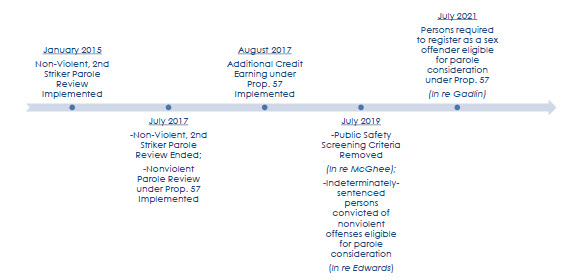
As a result of the significant changes in the law governing the nonviolent parole review process described above, the number of determinately-sentenced persons referred to the Board and the number approved for release has varied annually since 2015:9
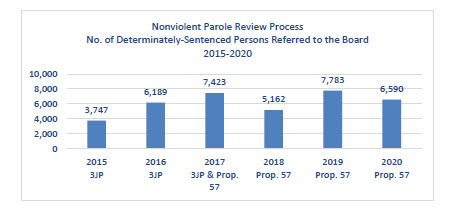
9 The number of persons referred to the Board each year differs from the number of decisions rendered each year, due to a variety of factors, including delay between the date a person is referred and the date a decision is rendered to allow the incarcerated person, registered victims, and prosecuting agency to be notified and provide an opportunity to submit written statements for the Board’s consideration.
The number of determinately-sentenced persons approved for release has also varied annually from a high of 1,801 in 2017 to a low of 860 in 2019:

The percentage of determinately-sentenced persons approved for release has varied from a high of 51 percent in 2015 for nonviolent, non-sex registrant, second-strikers who had served at least 50 percent of their term with no recent rules violations under the court-ordered process to a low of 17 percent for persons convicted of nonviolent offenses who served the full term for their primary offense regardless of their recent in-prison behavior, and who were not otherwise released “on the natural” with increased credit earning under Proposition 57 in 2020.
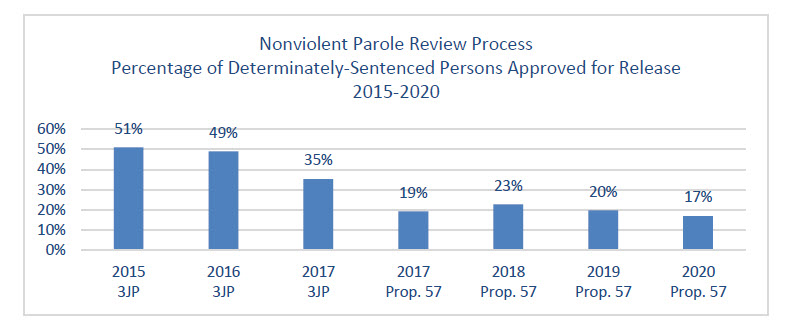
The Board has found that each time parole eligibility is quickly expanded, the initial impact is that incarcerated people are considered for parole who were not expecting it. Often persons are considered for parole who have not had the opportunity or incentive to actively engage in rehabilitative programming. However, as eligibility criteria stabilizes and more people are determined to be eligible for parole consideration upon admission to CDCR, more people are expected to actively participate in rehabilitative programming earlier in their incarceration and the number of people approved for release increases.
Procedural Overview
This section provides a more detailed explanation of the administrative procedures and timelines associated with the Proposition 57 nonviolent parole review process for determinately-sentenced persons. As mentioned above, determinately-sentenced persons convicted of nonviolent offenses are eligible for parole consideration under Proposition 57 once they have served the full term of their primary offense. Proposition 57 defines primary term as “the longest term of imprisonment imposed by the court for any offense, excluding the imposition of an enhancement, consecutive sentence, or alternative sentence.”10
A Nonviolent Parole Eligible Date (NPED) is the date on which the person is first eligible for parole consideration. Within 60 days of admission to prison, Case Records staff determine a person’s eligibility for parole consideration and if eligible, calculate the person’s NPED. An NPED is calculated by first identifying the longest term of imprisonment that is not an enhancement or alternative sentence and then subtracting any days the person has spent in custody prior to admission to CDCR.11 Eligibility determinations and NPED calculations are served on the incarcerated person within 15 days and are subject to CDCR’s administrative appeal process to address any alleged errors.12
A person is referred to the Board for parole consideration 35 days prior to their NPED so long as they have at least six months remaining to serve on their sentence and they are not, or will not within a year, be eligible for a parole consideration hearing as a determinately-sentenced youth offender or as a determinately-sentenced person eligible for a parole hearing under elderly parole.13 If the person is not approved for release, they are eligible for review and possible referral to the Board again annually.14 When a person is referred for parole consideration, they are served with a Notice of Rights explaining the process, including the opportunity to submit a written statement to be considered by the Board.15
10 Cal. Const., art. I, § 32, subd. (a), par. (1).
11 Cal. Code Regs., tit. 15, § 3490, subd. (f).
12 Cal. Code Regs., tit. 15, § 3491, subds. (f), (g).
13 Cal. Code Regs., tit. 15, § 3492, subd. (a); determinately-sentenced persons who were under the age of 26 at the time of their offense are eligible for a parole consideration hearing as a youth offender once they have served 15 years of incarceration and determinately-sentenced persons who are age 50 and who have served 20 years are eligible for a parole consideration hearing under elderly parole, exceptions apply. (See, Pen. Code, §§ 3051, 3055).
14 Cal. Code Regs., tit. 15, § 3492, subd. (b).
15 Cal. Code Regs., tit. 15, § 3492, subd. (c).
Below is a timeline of procedures once a determinately-sentenced person is referred for parole consideration under Proposition 57.16
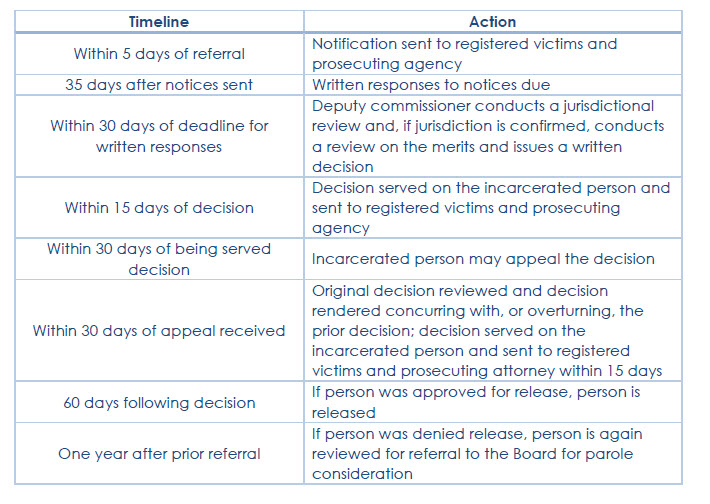
Release Decisions
The Board’s deputy commissioners are responsible for reviewing determinately-sentenced persons for discretionary release under Proposition 57. The Board’s deputy commissioners are experienced attorneys and their civil service classification is administrative law judge. The Board employs about 50 administrative law judges.
Deputy commissioners come from a wide variety of professional backgrounds and experience. Many have private practice experience in family law, criminal defense, immigration, workers’ compensation, and taxation. Others have experience in the public sector as public defenders and prosecutors. Some have experience working with nonprofit entities, and in juvenile dependency proceedings. Lastly, a few have experience as a judge or judge pro tem or served in the military, and one has experience in law enforcement.
16 See, Cal. Code Regs., tit. 15, §§ 2449.1 – 2449.7; Cal. Code Regs., tit. 15, § 3492.
New deputy commissioners receive a minimum of eight weeks of training, and all their decisions are monitored and reviewed for the first six to eight months, followed by periodic review thereafter. In addition, deputy commissioners receive continuing education monthly. Training topics for deputy commissioners include the law governing the Board’s decisions, risk assessment, correctional policies and procedures, disabilities and reasonable accommodations under the Americans with Disabilities Act, ethics, implicit bias, and structured decision-making.
In addition to conducting nonviolent parole reviews under Proposition 57, deputy commissioners also serve on hearing panels with commissioners for parole suitability hearings (i.e., parole hearings for persons serving life with the possibility of parole, youth offenders, elderly parole, and medical parole). They also conduct annual and certification hearings under Penal Code section 2960 et seq. for persons with mental health disorders, review parolees for discharge from supervised release, and adjudicate a variety of pre-hearing matters for the Board’s parole hearing process.
When conducting a nonviolent parole review under Proposition 57, deputy commissioners must review and consider all relevant and reliable information, including:
- information contained in the incarcerated person’s central file, including their California Static Risk Assessment score;
- the person’s criminal history;
- any return to prison with a new conviction after previously being approved for release under Proposition 57; and
- written statements by the incarcerated person, registered victims, and the prosecuting agency.17
Incarcerated persons are approved for release if they do not pose a current, unreasonable risk of violence or a current unreasonable risk of significant criminal activity.18 Deputy commissioners are required to evaluate specific risk factors concerning the person’s current conviction(s), prior criminal behavior, institutional behavior, work history, and rehabilitative programming. The Board’s regulations list specific evidence-based factors that aggravate or mitigate the person’s risk. For example, crimes in which a person personally used a deadly weapon aggravate the person’s risk, whereas crimes that do not involve personal use of a deadly weapon mitigate the person’s risk.19
17 Cal. Code Regs., tit. 15, § 2449.4, subd. (b).
18 Cal. Code Regs., tit. 15, § 2449.4, subd. (f).
19 Cal. Code Regs., tit. 15 § 2449.5, subds. (b)-(g).
Deputy commissioners render a decision based on the totality of the circumstances.20 Incarcerated persons shall be approved for release if factors aggravating their risk do not exist or if they are outweighed by factors mitigating their risk. Deputy commissioners must also take into account the relevance of the information based on the passage of time, the person’s age, and the person’s physical and cognitive limitations, if any.21 Decisions are rendered in writing and must include a statement of reasons supporting the decision.22 Decisions approving a person for release two or more years prior to the end of their term must be reviewed and approved by a supervising deputy commissioner.23
Incarcerated persons may request review of a Board decision within 30 calendar days of being served the decision.24 In addition, the Board may at any time prior to a person’s release, review its decision if the decision contained an error of law, an error of fact, or if the Board receives new information that would have materially impacted the previous decision had it been known at the time the decision was issued.25 A deputy commissioner not involved in the original decision will review the decision within 30 days and determine whether to concur with the original decision or overturn it.26 The resulting written decision must be supported by a statement of reasons.27 The incarcerated person, registered victims, and prosecutors are notified of the outcome.28
Persons approved for release are released 60 days from the date of the Board’s decision and persons denied release are reviewed again annually until they are either approved for release by the Board, they are released “on the natural” based on the sentence imposed by the court, or they become eligible for a parole consideration hearing as a determinately-sentenced youth offender or under elderly parole.29
20 Id.
21 Cal. Code Regs., tit. 15, § 2449.5, subd. (a).
22 Cal. Code Regs., tit. 15, § 2449.4, subd. (d).
23 Cal. Code Regs., tit. 15, § 2449.4, subd. (f).
24 Cal. Code Regs., tit. 15, § 2449.7, subd. (a).
25 Cal. Code Regs., tit. 15, § 2449.7, subd. (b).
26 Cal. Code Regs., tit. 15, § 2449.7, subd. (d).
27 Id.
28 Cal. Code Regs., tit. 15, § 2449.7, subds. (e), (f).
29 Cal. Code Regs., tit. 15, §§ 3491-3493.
